One of the main components of the PTE test is the Speaking section, which is designed to evaluate the test taker’s ability to speak English in a variety of different contexts.
The PTE Speaking section is scored based on a number of factors, including pronunciation, fluency, vocabulary, and grammar. Test takers receive a score between 10 and 90 for each question, with a score of 90 indicating that the test taker has a native-like level of spoken English. The scores for each question are then combined to give the test taker an overall Speaking score, which can range from 10 to 90.

In this blog post, we will take a closer look at the PTE Speaking section, including what it covers, how it is scored, and tips for preparing for the test.
What is the PTE Speaking format?
There are six different question types in PTE Speaking section. Each question type is designed to assess a different aspect of the test taker’s speaking ability. For example, the Repeat Sentence question tests the test taker’s ability to understand spoken English and repeat it accurately, while the Describe Image question tests the test taker’s ability to speak clearly and effectively describe a visual image.
In the actual PTE test, the Speaking and the Writing sections are combined into a single section as Part 1: Speaking & Writing. However, here we have analyzed them separately.
Personal Introduction (not scored)
The Personal Introduction question is a chance for you to become familiar with the technology used in the PTE test, and to help you prepare for the speaking and listening sections. Note that this question does not affect your final score and is only intended for familiarization purposes.
You are given 25 seconds to read the prompt and prepare, followed by 30 seconds to record your response. You will not be given the opportunity to record your answer more than once.
Read aloud
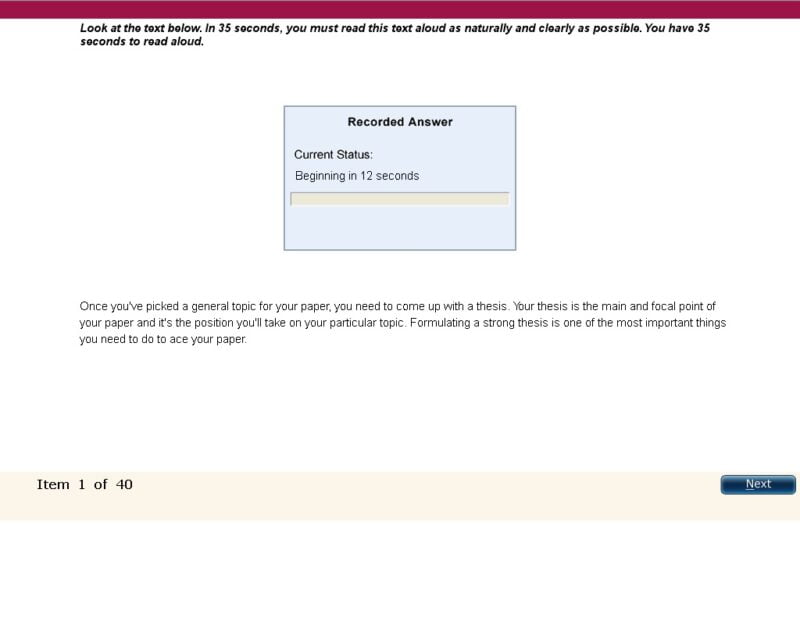
A paragraph is displayed on the screen, and you have to read it into the microphone. Each question is approximately 60 words in length. Microphone does not open immediately after the paragraph appears. You have 30 to 40 seconds to examine the text. After the preparation time, you will see a “Recording” sign on your screen when you should start speaking. You have another 30 to 40 seconds to record your answer.
Repeat sentence
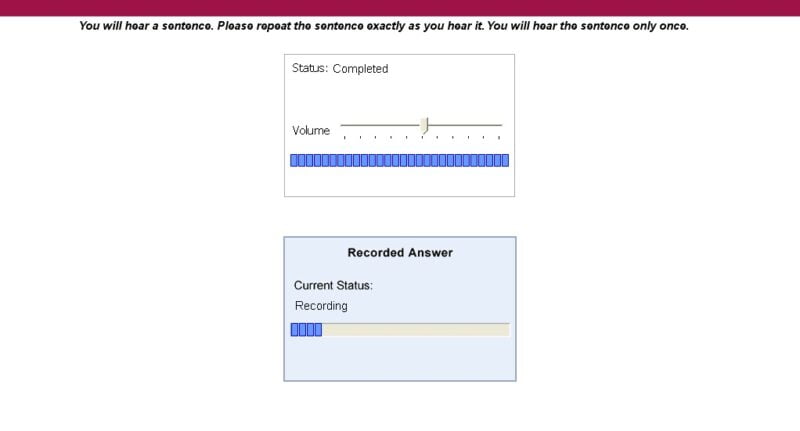
Number of questions: 10 to 12
You will hear a sentence. After listening to the sentence, you should repeat the sentence as exactly as hear it. The sentence will be short, and you will only heart it only once. The time provided to record your answer is 15 seconds.
Describe image
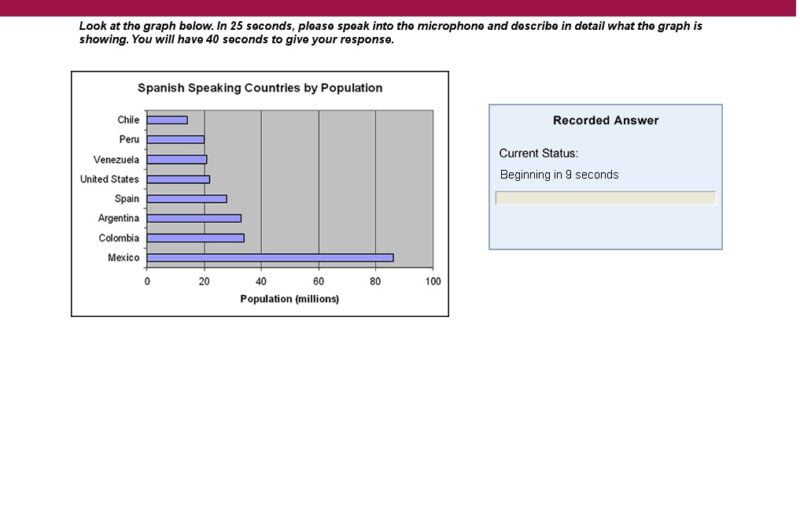
Number of questions: 3 to 4
An image will be displayed on the screen. This image may contain bar graphs, line graphs, pie charts, diagrams, photographs, or maps. The task is to describe in detail what the graph is showing. The length of time allocated for describing is 40 seconds, while 25 seconds are given before speaking for preparation.
• PTE Describe Image format: Tried and tested template for 2023
Re-tell lecture
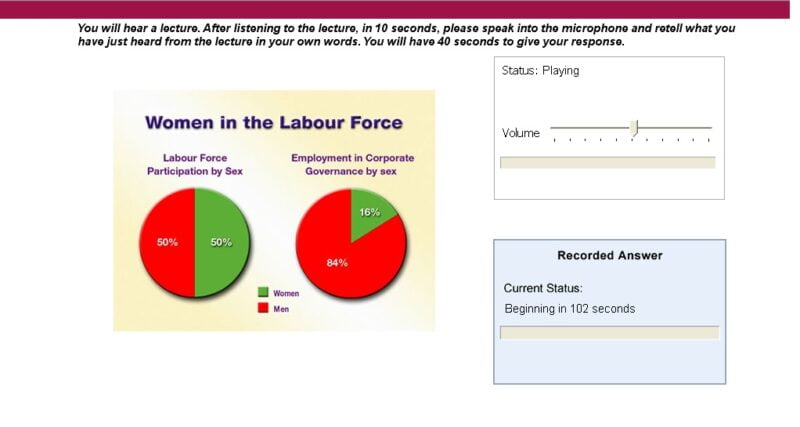
Number of questions: 1 to 2
A short lecture of under 2 minutes is played first. After listening to the lecture, the task is to retell what you have just heard from the lecture. You can use pen and paper to take notes while listening. The audio is played only once, and you are given 40 seconds to record the answer.
Answer short questions
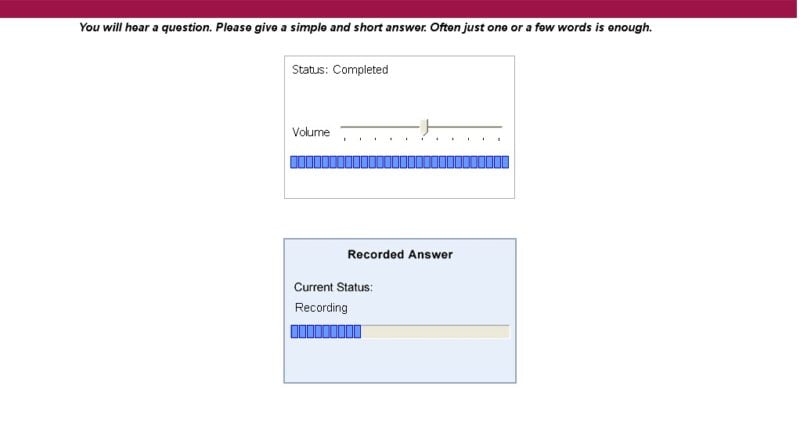
Number of questions: 5 to 6
A direct question is played for you, and you have to give a simple and short answer. Often just one word or a few words is enough. The questions test your awareness of English vocabulary. You get 10 seconds to answer each question.
How can I practice PTE Speaking?
To prepare for the PTE Speaking section, test takers can start by familiarizing themselves with the different question types and the skills that they assess. For example, if you are weak at fluency, practice speaking English as much as possible, and try to focus on speaking clearly and at a steady pace. Additionally, it is helpful to practice with real PTE practice tests and questions, as well as online resources. It is also a good idea to record yourself speaking and listen back to your responses to identify areas for improvement.
In addition to working on specific speaking skills, test takers can also prepare for the PTE Speaking section by improving their overall English language proficiency. This can be done by studying vocabulary, grammar, and reading and listening to authentic English-language materials.
One of the best ways to improve your PTE Speaking score is to get familiar with the test format and question types. By understanding the format and knowing what to expect, you will be able to anticipate the types of questions that will be asked and prepare accordingly.
The PTE Speaking section is an important part of the PTE test and is designed to evaluate the test taker’s ability to speak English in a variety of different contexts. By familiarizing yourself with the different question types and the skills that they assess, as well as working on your overall English language proficiency, you can improve your PTE Speaking score and increase your chances of success on the PTE test. Remember that practice, practice and more practice is the key to excel in PTE Speaking section as well as PTE test as a whole.

Which questions carry more marks in Speaking?
Not every question in the Speaking section of the PTE test is important for a high score. Refer to the table below to understand the marks distribution in test.
| Question type | Number of questions | Speaking score | Writing score | Reading score | Listening score | % of total score |
|---|---|---|---|---|---|---|
| Personal introduction | 1 | 0 | 0 | 0 | 0 | 0 |
| Read aloud | 6 – 7 | 22.2 | 22.1 | 12.31 | ||
| Repeat sentence | 10 – 12 | 32.1 | 19.7 | 14.39 | ||
| Describe image | 3 – 4 | 22.2 | 6.17 | |||
| Retell lecture | 1 – 2 | 11.1 | 9.9 | 5.81 | ||
| Answer short questions | 5 – 6 | 2.4 | 6.6 | 2.50 | ||
| Total | 26 – 32 | 90 | 0 | 22.1 | 36.2 | 41.18 |
So you can see from the above table that Read aloud and Repeat sentence are the most important questions in the PTE Speaking section.
You can also notice that many questions from the PTE Speaking section contain marks for the other sections as well. For an example, if you do well in the Read aloud question, marks will be carried over to the PTE Reading section as well.
Is PTE Speaking easy? Is PTE Speaking hard?

The difficulty of PTE Speaking can vary depending on a variety of factors, such as your level of proficiency in English, your familiarity with the test format and requirements, and your confidence and ability to express yourself orally.
Generally, the PTE Speaking section includes five different task types, ranging from reading aloud and describing an image to answering questions and summarizing a spoken text. Each task is designed to assess specific aspects of your speaking skills, such as pronunciation, fluency, vocabulary, and grammar.
Some test-takers may find certain tasks more challenging than others, depending on their strengths and weaknesses in speaking. For example, reading aloud may be easier for someone who is good at pronunciation but harder for someone who struggles with reading comprehension. On the other hand, describing an image may be more difficult for someone who lacks vocabulary or grammar skills.
Overall, it’s difficult to say whether PTE Speaking is easy or difficult without knowing more about your individual abilities and experience with the test. However, with practice and preparation, you can improve your speaking skills and become more confident in your ability to do well on the test.
How do you score 90 in PTE Speaking?
Scoring 90 in PTE Speaking is a challenging task, but it’s achievable with the right preparation and approach. Here are some tips that can help you achieve a high score in the PTE Speaking section:
- Understand the test format: To score well in PTE Speaking, it’s essential to understand the test format and task types. Familiarize yourself with the different task types, such as read aloud, repeat sentence, describe image, retell lecture, answer short question, and summarize spoken text.
- Work on your pronunciation and fluency: Pronunciation and fluency are critical aspects of PTE Speaking. Work on your pronunciation by practicing the correct sounds, intonation, and stress patterns. Focus on fluency by practicing speaking at a natural pace, using cohesive devices, and avoiding pauses or hesitations.
- Know which questions are more important: Read aloud and Repeat sentence are the most important questions in PTE Speaking, so spend more time preparing for them.
- Practice regularly: Regular practice is crucial for improving your speaking skills. Use PTE Speaking practice tests, record your responses, and listen to them to identify areas for improvement.
- Manage your time effectively: Time management is crucial for a high score in PTE Speaking. Practice speaking within the allotted time for each task, and make sure to pace yourself to complete all the tasks within the given time.
- Stay calm and confident: Finally, stay calm and confident during the test. Nervousness and anxiety can negatively impact your performance. Take deep breaths, stay focused, and approach each task with confidence.
By following these tips, you can improve your PTE Speaking skills and aim for a high score of 90 or above.
Gaurav Thapa is an experienced instructor of English as a Foreign Language. He has eight years of experience teaching IELTS and PTE.